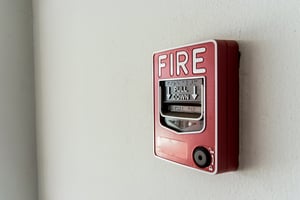9 Ways to Keep Your Techs Safe.
.png?width=300&name=How%20to%20make%20jobsites%20safer468%20x%2060%20(1).png) Whether you run an oil rig, a commercial retail site, a manufacturing plant, a healthcare facility or another facility operation with lots of moving parts, jobsite safety is paramount. Here are 9 tips to keep your technicians safe on the job:
Whether you run an oil rig, a commercial retail site, a manufacturing plant, a healthcare facility or another facility operation with lots of moving parts, jobsite safety is paramount. Here are 9 tips to keep your technicians safe on the job:
1. Always Perform Thorough Walk-Throughs
Performing consistent, thorough walk-throughs can go a long way towards ensuring job-site safety. Trained professionals can identify potential hazards before they become a serious problem such as foundation instability, electric shock hazards, bio-hazards and more.
2. Train Personnel
Workers need to be able to take responsibility for their own safety. The best way to actively include them is to thoroughly train them in the necessary safety precautions for the associated job-site. Whether this involves a sharps disposal course for a healthcare facility, proper lifting techniques for a construction site, hazardous materials management for sanitation workers, it is crucial to maintain an educated workforce.
3. Mark and Store Materials Correctly
Speaking of hazardous materials, the easiest way to ensure they are treated with the proper care is to label and store them correctly. Beyond the obvious OSHA violations issue, this also improves site organization and reduces the chances of easily-avoided misunderstandings.
4. Inspect Equipment Frequently
Faulty equipment can be a serious threat to personal safety, so performing routine maintenance on it can make a huge difference in maintaining jobsite integrity. A maintenance calendar or a computerized maintenance management solution like the one from FacilityONE can make this process much smoother with automated alerts, easy scheduling features and many more useful capabilities.
5. Always Wear Safety Gear/Personal Protective Equipment
Making personal protective equipment like hard hats, high-vis vests, work boots, surgical masks, latex gloves and more a requirement for all personnel on a site is a crucial factor of safety. High visibility clothing prevents collisions with equipment or vehicles. Workboots prevent foot and toe crushing accidents. Surgical masks prevent the spread of disease between caregivers and patients. Asbestos filters and other breathing apparatuses prevent inhalation of harmful substances. It is absolutely vital to provide safety gear to employees, especially if there are pre-identified hazards to their safety that can be addressed.
 6. Know OSHA Standards
6. Know OSHA Standards
You can’t meet OSHA guidelines if you don’t know them, so it’s important to know your state, national and local laws regarding workplace safety. For example, California, Oregon, Michigan and Washington have stricter labor safety laws than OSHA imposes at the national level, so even though you might be adhering to national rules you could be breaking local restrictions.
7. Take Regular Breaks
This may seem like it doesn’t belong on this list, but taking regular breaks is very important to worker safety. Whether the employees are desk workers or heavy manual laborers, frequent breaks are vital to optimum performance. Regular breaks help to improve focus, reducing the likelihood of accidents caused by exhaustion or lack of attention. For workers on their feet, in the elements or using their bodies all day, it is especially important to give them the opportunity to rest and avoid heat exhaustion or injuries.
8. Do Your Paperwork
We get it — paperwork can be tedious, boring, and often feels like it doesn’t matter at all in the scope of things. Paperwork proves that employees have been trained, that materials are marked, that equipment has been inspected, that you know OSHA standards and that you’re prepared for emergencies. It promotes responsibility in all these areas — from a practicality viewpoint it’s usually more convenient to just do the task required on the paperwork rather than pretend or ignore the requirements — and protects you from liability if issues do occur despite your best efforts.
 9. Be Prepared for Emergencies
9. Be Prepared for Emergencies
No matter how careful you and your employees are, emergencies happen. Having a predefined plan for how to deal with these emergencies can be the difference between life and death. Running emergency drills can help prepare your team for how to react to a larger disaster like a fire or unexpected weather events. An emergency guideline booklet or procedure manual can put the power of reaction into the hands of those witnessing a safety emergency, so training employees is crucial step here as well. The more prepared your site is, the less likely you’ll be to have fatal accidents.
With these 9 steps, you're well on your way to ensuring a safe facility work environment for your facility mangers and technicians.
Did we miss something important? Please leave a comment below and subscribe to our blog for regular updates and operations industry best practices from FacilityONE® Technologies.



